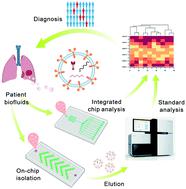Our official English website, www.x-mol.net, welcomes your feedback! (Note: you will need to create a separate account there.)
Advances in microfluidic extracellular vesicle analysis for cancer diagnostics
Lab on a Chip ( IF 6.1 ) Pub Date : 2021-07-28 , DOI: 10.1039/d1lc00443c Shibo Cheng 1 , Yutao Li , He Yan , Yunjie Wen , Xin Zhou , Lee Friedman , Yong Zeng
Lab on a Chip ( IF 6.1 ) Pub Date : 2021-07-28 , DOI: 10.1039/d1lc00443c Shibo Cheng 1 , Yutao Li , He Yan , Yunjie Wen , Xin Zhou , Lee Friedman , Yong Zeng
Affiliation

|
Extracellular vesicles (EVs) secreted by cells into the bloodstream and other bodily fluids, including exosomes, have been demonstrated to be a class of significant messengers that mediate intercellular communications. Tumor-derived extracellular vesicles are enriched in a selective set of biomolecules from original cells, including proteins, nucleic acids, and lipids, and thus offer a new perspective of liquid biopsy for cancer diagnosis and therapeutic monitoring. Owing to the heterogeneity of their biogenesis, physical properties, and molecular constituents, isolation and molecular characterization of EVs remain highly challenging. Microfluidics provides a disruptive platform for EV isolation and analysis owing to its inherent advantages to promote the development of new molecular and cellular sensing systems with improved sensitivity, specificity, spatial and temporal resolution, and throughput. This review summarizes the state-of-the-art advances in the development of microfluidic principles and devices for EV isolation and biophysical or biochemical characterization, in comparison to the conventional counterparts. We will also survey the progress in adapting the new microfluidic techniques to assess the emerging EV-associated biomarkers, mostly focused on proteins and nucleic acids, for clinical diagnosis and prognosis of cancer. Lastly, we will discuss the current challenges in the field of EV research and our outlook on future development of enabling microfluidic platforms for EV-based liquid biopsy.
中文翻译:

用于癌症诊断的微流体细胞外囊泡分析的进展
细胞分泌到血流和其他体液(包括外泌体)中的细胞外囊泡(EV)已被证明是一类介导细胞间通讯的重要信使。肿瘤来源的细胞外囊泡富含来自原始细胞的一组选择性生物分子,包括蛋白质、核酸和脂质,从而为液体活检用于癌症诊断和治疗监测提供了新的视角。由于 EV 的生物发生、物理性质和分子成分的异质性,EV 的分离和分子表征仍然极具挑战性。微流控技术因其固有的优势,为EV分离和分析提供了一个颠覆性的平台,可促进新型分子和细胞传感系统的开发,提高灵敏度、特异性、空间和时间分辨率以及通量。这篇综述总结了与传统同行相比,用于 EV 分离和生物物理或生化表征的微流体原理和设备开发的最先进进展。我们还将调查采用新的微流体技术来评估新兴的 EV 相关生物标志物(主要集中于蛋白质和核酸)的进展,以用于癌症的临床诊断和预后。最后,我们将讨论 EV 研究领域当前的挑战以及我们对基于 EV 的液体活检的微流控平台未来发展的展望。
更新日期:2021-08-05
中文翻译:

用于癌症诊断的微流体细胞外囊泡分析的进展
细胞分泌到血流和其他体液(包括外泌体)中的细胞外囊泡(EV)已被证明是一类介导细胞间通讯的重要信使。肿瘤来源的细胞外囊泡富含来自原始细胞的一组选择性生物分子,包括蛋白质、核酸和脂质,从而为液体活检用于癌症诊断和治疗监测提供了新的视角。由于 EV 的生物发生、物理性质和分子成分的异质性,EV 的分离和分子表征仍然极具挑战性。微流控技术因其固有的优势,为EV分离和分析提供了一个颠覆性的平台,可促进新型分子和细胞传感系统的开发,提高灵敏度、特异性、空间和时间分辨率以及通量。这篇综述总结了与传统同行相比,用于 EV 分离和生物物理或生化表征的微流体原理和设备开发的最先进进展。我们还将调查采用新的微流体技术来评估新兴的 EV 相关生物标志物(主要集中于蛋白质和核酸)的进展,以用于癌症的临床诊断和预后。最后,我们将讨论 EV 研究领域当前的挑战以及我们对基于 EV 的液体活检的微流控平台未来发展的展望。



























 京公网安备 11010802027423号
京公网安备 11010802027423号